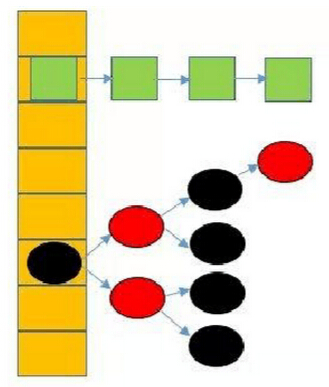前言
回想之前几次的面试,没有一次不问到 hashmap 的,这也体现了 hashmap 的重要性了。记得当时的回答是底层是数组加链表的方式实现的,然后就是什么 get 时候怎么查找的。现在想想这些小白都知道的东西说出来也加不了分啊。现在挤点时间出来看看源码吧。
底层实现简介
数组加链表这个没什么好说的,看下面这个图就能明白了(java8当中当链表达到一定长度就会转换成红黑树,这个之后再说)。还是从源码来看吧,这里时间问题不可能每个方法都拿出来讲了,挑几个重要的方法来说。

HashMap(int, float)
第一个参数是容量默认为16,第二个参数是负载因子默认是0.75。源码如下:
1 | public HashMap(int initialCapacity, float loadFactor) { |
直接看 tableSizeFor(initialCapacity) 这个方法,由于 hashmap 的容量总是2的幂,所以这个方法就是找到大于等于 initialCapacity 的最小的2的幂
1 | /** |
tableSizeFor 方法为什么这么设计呢, 我们假设假设n只有最高位是1后面低位全是0,和无符号右移1位相或,得到最高位、次高位是1,后面低位均是0。再与无符号右移2位相或,得到高四位是1后面均是0。下面同理,或上无符号右移4位,得到高8位是1。或上无符号右移8位,得到高16位为1。或上无符号右移16位,得到32位全是1。此时已经大于 MAXIMUM_CAPACITY 了,没必要继续了。返回 MAXIMUM_CAPACITY 即可。这是在cap <= MAXIMUM_CAPACITY 最极致的情况了。
tableSizeFor 方法返回值赋值给了 threshold ?为什么不是下面这样了
1 | this.threshold = tableSizeFor(initialCapacity) * this.loadFactor; |
在这个构造方法中并没有对 table 数组初始化,初始化是第一次 put 操作的时候进行的,到时候会对 threshold 重新进行计算,这个不用我们担心😓。
put(K, V)
1 | public V put(K key, V value) { |
1 | static final int hash(Object key) { |
1 | /** |
resize( )
这个方法会在初始化和 size 超过 threshold 的时候执行。
1 | /** |
简单说下上面怎么区分原来链表的节点是应该放在 low 位还是 high 位的,假设一个 key 的 hash 为 00001100,哈希桶的容量是16,也就是 00010000。那么 00001100 & 00001111 = 00001100,也就是角标为12的桶中,而另一个 key 的 hash 为00011100,00011100 & 00001111 = 00001100,那么它也在角标为12的桶中。但是这两个 key 的 hash 分别和 00010000 相与,结果刚好差了一个旧容量的大小。也就是根据 key 的 hash 和旧容量为1的那位对应的是0还是1,是0的话就放在 low 位,是1就放在 high 位。
get(Object)
1 | public V get(Object key) { |
1 | final Node<K,V> getNode(int hash, Object key) { |
红黑树相关方法
红黑树相关知识网上有很多不错的讲解,推荐一个github地址,感兴趣可以去看一下,教你透彻了解红黑树
先来 TreeNode 有什么属性吧
1 | TreeNode<K,V> parent; // red-black tree links |
记得之前在 putVal( ) 方法中,如果追加节点后链表长度>=8就会转换为树。其中 treeifyBin(tab, hash) 方法如下
1 | final void treeifyBin(Node<K,V>[] tab, int hash) { |
现在 hd 就是之前链表头节点转换成的 treeNode,它的 next 指向下一个 treeNode,并且这个 treeNode 的 prev 指向 hd,后面同理。然后来看下 hd.treeify(tab)
1 | final void treeify(Node<K,V>[] tab) { |
接着看下 balanceInsertion(root, x)怎么重新指定root的
1 | static <K,V> TreeNode<K,V> balanceInsertion(TreeNode<K,V> root, |
上面这个方法看不懂的话主要还是红黑树没有理解。建议先理解下红黑树。移除修复操作大同小异,这里就不做记录了。
其他新增方法
带有默认值的get
1
2
3
4
5
public V getOrDefault(Object key, V defaultValue) {
Node<K,V> e;
return (e = getNode(hash(key), key)) == null ? defaultValue : e.value;
}存在则不覆盖的put,调用putVal( )
1
2
3
4
public V putIfAbsent(K key, V value) {
return putVal(hash(key), key, value, true, true);
}根据key和value移除
1
2
3
4
public boolean remove(Object key, Object value) {
return removeNode(hash(key), key, value, true, true) != null;
}
还有一些其它的方法没有说到,感兴趣的可以去看下源码。
LinkedHashMap
顺便简单说下 LinkedHashMap 吧,与 HashMap 最主要的区别是,其内部维护的双向链表,可以按照插入顺序或者最近访问顺序遍历取值。
1 | public LinkedHashMap() { |
1 | public LinkedHashMap(int initialCapacity, |
其中用 Entry<K, V> 继承了 HashMap.Node<K, V>,通过 before 和 after 实现了双向链表
1 | static class Entry<K,V> extends HashMap.Node<K,V> { |
get(Object)
1 | public V get(Object key) { |
1 | void afterNodeAccess(Node<K,V> e) { // move node to last |
如果 accessOrder 为 true,上面的操作就是调整 get 的那个节点e至尾部,且修复之前e节点的前节点的 after 指针,后节点的 before 指针的指向。
至于 HashMap 预留给 LinkedHashMap 的 afterNodeAccess()、afterNodeInsertion() 、afterNodeRemoval() 方法 平时不怎么用到,这里不做介绍了。